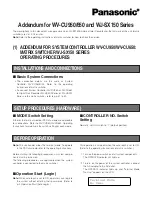
DWS-3160 Series Gigabit Ethernet Unified Switch CLI Reference Guide
977
which the AP may establish a connection. The certificates are distributed when the mutual
authentication feature is enabled, during AP and Switch provisioning, and triggered by an
administrator command.
The X.509 mutual certificate exchange is the only mechanism for peer Switches to authenticate
with each other because Switches don't support pass-phrase authentication. Note that if the
wireless Switch is currently managed by a cluster controller, then any provisioning request toward
this Switch will fail.
When the X.509 mutual authentication is enabled the AP and peer Switch discovery is slower than
when this feature is disabled because certificates are exchanged during the TLS connection setup.
Certification Overview and Usage In the Wireless System:
The TLS connection has two sides: a client side initiates the connection and the server side
accepts the connection. In a Wireless System, the APs act only as TLS clients, and Switches act
as either TLS clients or TLS servers. The Switch acts as a TLS client when it establishes a
connection to a peer Switch.
The TLS protocol supports client verification of server certificates and mutual certificate verification.
The Wireless System configures the TLS session to use mutual certificate verification when the
mutual authentication mode is enabled. When the mutual authentication mode is disabled, the
Wireless System uses anonymous cipher and disables certificate exchange and verification.
In order to verify the certificate each device generates a private key and an X.509 certificate. The
private key is kept on the device and is not given out to other Switches or APs. The certificate
contains a matching public key. The device certificate is given out to other devices in the wireless
system. Data encrypted with the public key using the device's certificate can be decrypted with the
device's private key.
The certificates are encoded using PEM format, which is a Base64 encoded file. The Base64
encoding uses printable ASCII characters to represent binary data. Before the certificate files can
be used for certificate validation they are loaded into the OpenSSL library.
Each wireless device has a copy of a certificate of the device with which it needs to communicate.
During TLS connection establishment the Wireless devices compare the certificate received on the
connection setup with all available loaded certificates for other wireless devices. If a matching
certificate is found then the certificate verification succeeds. The verification function does not
attempt to correlate the IP address of the device with the certificate and it does not check the
certificate expiration date.
The TLS connections are configured to validate the certificates only on the initial connection setup.
The connection reauthentications don't trigger new certificate validation attempts.
Certificate Generation on the Access Point:
Содержание DWS-3160 Series
Страница 1: ......
Страница 13: ...DWS 3160 Series Gigabit Ethernet Unified Switch CLI Reference Guide 9 R refresh the displayed pages ...
Страница 271: ...DWS 3160 Series Gigabit Ethernet Unified Switch CLI Reference Guide 267 ...
Страница 586: ...DWS 3160 Series Gigabit Ethernet Unified Switch CLI Reference Guide 582 ...
Страница 766: ...DWS 3160 Series Gigabit Ethernet Unified Switch CLI Reference Guide 762 ...



































